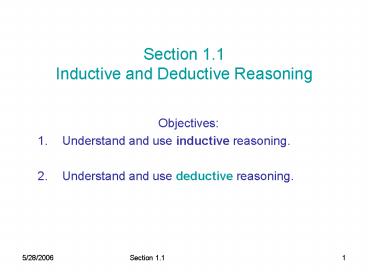Section 1'1 Inductive and Deductive Reasoning - PowerPoint PPT Presentation
1 / 15
Title:
Section 1'1 Inductive and Deductive Reasoning
Description:
What comes next in this list of numbers? 1, 1, 2, 3, 5, 8, 13, 21, ... All proper names are prohibited in Scrabble. TEXAS is a proper name. Conclusion: ... – PowerPoint PPT presentation
Number of Views:53
Avg rating:3.0/5.0
Title: Section 1'1 Inductive and Deductive Reasoning
1
Section 1.1Inductive and Deductive Reasoning
- Objectives
- Understand and use inductive reasoning.
- Understand and use deductive reasoning.
2
Inductive Reasoning
- The process of arriving at a general conclusion
based on observations of specific examples. - Definitions
- Conjecture/hypothesis The conclusion formed as
a result of inductive reasoning which may or may
not be true. - Counterexample A case for which the conjecture
is not true which proves the conjecture is false.
3
Strong Inductive Argument
- In a random sample of 1172 U.S. children ages 6
through 14, 17 said being bossed around is a bad
thing about being a kid. We can conclude that
there is a 95 probability that between 14.1 and
19.9 of all U.S. children ages 6 through 14 feel
that getting bossed around is a bad thing about
being a kid. - This technique is called random sampling,
discussed in Chapter 12. Each member of the group
has an equal chance of being chosen. We can make
predictions based on a random sample of the
entire population.
4
Weak Inductive Argument
- Men have difficulty expressing their feelings.
Neither my dad nor my boyfriend ever cried in
front of me. - This conclusion is based on just two
observations. - This sample is neither random nor large enough to
represent all men.
5
Example 1 Identifying a pattern in a list of
numbersusing addition
- What number comes next?
- Solution Since the numbers are increasing
relatively slowly, try addition. - The common difference between each pair of
numbers is 9. - Therefore, the next number is 39 9 48.
6
Example 2 Identifying a pattern in a list of
numbersusing multiplication
- What number comes next?
- Solution Since the numbers are increasing
relatively quickly, try multiplication. - The common ratio between each pair of numbers is
4. - Thus, the next number is 4 x 768 3072.
7
Example 3Fibonacci Sequence
- What comes next in this list of numbers?
- 1, 1, 2, 3, 5, 8, 13, 21, ?
- Solution This pattern is formed by adding the
previous 2 numbers to get the next number - So the next number in the sequence is
- 13 21 34
8
Example 4Predicting the next figure in a
sequence by finding the pattern
- Describe two patterns in this sequence of
figures. Use the pattern to draw the next
figure.
9
Example 4 continued
- Solution The first pattern concerns the shapes.
- We can predict that the next shape will be a
Circle - The second pattern concerns the dots within the
shapes. - We can predict that the dots will follow the
pattern from 0 to 3 dots in a section with them
rotating counterclockwise so that the figure is
as below.
10
Inductive ReasoningMore than one Solution!
- 1, 2, 4, ?
- What is the next number in this sequence?
- If the pattern is to add 2 to the previous number
it is 6. - If the pattern is to multiply the previous number
by 2 then the answer is 8. - We need to know one more number to decide.
- Is this illusion a wine
- Goblet or two faces
- looking at each other?
11
Deductive Reasoning
- The process of proving a specific conclusion from
one or more general statements. - Theorem A conclusion proved true by deductive
reasoning
12
Example 5An Example in Everyday Life
13
Deductive Reasoning
- Examples from Mathematics
- Suppose 3x 12. We conclude x 4.
- The length of a rectangle is 6 and its width
is 5. We conclude its area is 30.
14
Example 6Finding a number pattern as a sequence
of operationsUsing Inductive Reasoning, apply
the rules to specific numbers. Do you see a
pattern?
15
Example 6 continued
- Solution
- Using Deductive reasoning, use n to represent the
number - Does this agree with your inductive hypothesis?































